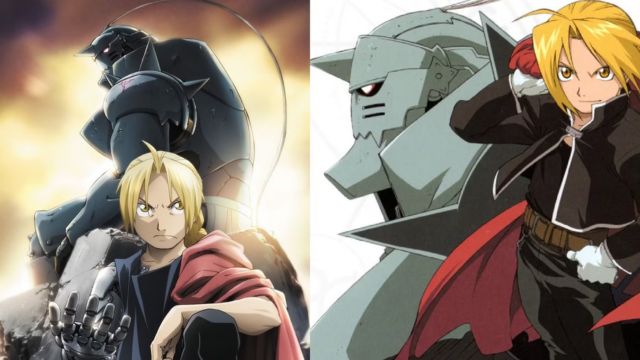What’s the Difference Between Fullmetal Alchemist and Brotherhood?
Fullmetal Alchemist is considered as one of the preeminent comics and anime in history. The narrative of the Elric Brothers, Edward and Alphonse, as they endeavor to restore their bodies and inadvertently uncover a profound conspiracy threatening the entire continent, has captivated audiences for years.
Many fans inquire about the distinctions between the two anime adaptations of Fullmetal Alchemist and Brotherhood.
Although both adaptations are rooted on the same narrative, significant disparities exist between Fullmetal Alchemist and Fullmetal Alchemist: Brotherhood. For those inclined to engage, one version adheres more directly to the original manga’s narrative, whereas the other delves further into concepts that were only superficially addressed.
The pronounced disparities are fundamentally what fuel the dispute between Fullmetal Alchemist and Brotherhood.
Fullmetal Alchemist was a quintessential anime series from the 2000s, and its manga enjoyed comparable popularity. A new version of the anime, titled Fullmetal Alchemist: Brotherhood, was created due to discrepancies from the original source material, offering greater fidelity.
Presently, this type of anime remake is more prevalent than ever, prompting numerous fans to compare the two iterations. The dispute between Fullmetal Alchemist and Brotherhood mostly hinges on the significance of manga fidelity, among other factors.
FMA: Brotherhood Stays Truer to the Manga
The basic difference between Fullmetal Alchemist and Brotherhood is in the level of their adaptation of Hiromu Arakawa’s manga. Upon the premiere of the inaugural Fullmetal Alchemist series in October 2003, merely five volumes of the manga had been published, with the sixth volume debuting later that month.
At the conclusion of the anime in October 2004, eight volumes had been released. This indicates that Bones, the animation company responsible for Fullmetal Alchemist, possessed merely a portion of the final 27-volume manga for adaptation.
In contrast, the concluding episode of Fullmetal Alchemist: Brotherhood coincided with the publication of the manga’s final chapter. Brotherhood was designed to be a more accurate adaptation.
Both series utilize a shared frame of reference, adapting the events of the manga up to Maes Hughes’ demise, then diverging into distinct narratives thereafter. Consequently, it is correct to assert that Fullmetal Alchemist post-episode 26 and Fullmetal Alchemist: Brotherhood post-episode 10 narrate wholly distinct storylines.
The original series makes choices that further develop events and characters. Additional work was devoted to developing the characters of Barry the Chopper and Shou Tucker, allowing viewers to gain a deeper understanding of them.
The Brotherhood anime remake, in contrast, presents these supporting antagonists at the point of their narrative significance. Among all the secondary characters whose roles were modified, Rose’s alterations were the most significant.
She transitions from a peripheral character introduced early on to a pivotal element of the villain Dante’s overarching scheme. Rose is subjected to brutality and exploited as a conduit for Dante upon acquiring the Philosopher’s Stone.
Significant stuff is introduced in the early episodes that is absent from the manga. For example, Russell and Fletcher Tringham are characters derived from the light novel The Land of Sand rather than the manga.
Nevertheless, certain comic characters, such as Olivier Mira Armstrong, are absent from the original anime. A prevalent criticism is that the female characters in the original series, such as Winry and Riza, do not receive the same degree of development or significance to the narrative as they do in Brotherhood.
They resemble background characters, which precluded their possibility for development. This establishes a significant distinction between FMA and Brotherhood.
The Function and Origin of Homunculi in FMA Compared to FMAB
Another difference between FMA and FMAB is in the portrayal of the primary antagonists. The Homunculi function as the principal adversaries in both anime, although their creators and identities vary between series.
Every Homunculus is designated after one of the seven deadly sins. In both anime, Lust, Gluttony, and Envy are fundamentally unchanged, while Lust in the original serves as the principal antagonist with a significantly enhanced role. In contrast, Lust is the inaugural character to perish in Brotherhood.
Conversely, Pride, Wrath, Sloth, and Envy are fundamentally distinct. In Brotherhood, Wrath is Fuhrer Bradley, and Pride is his son; conversely, in the original anime, Bradley is identified as Pride.
In FMA, Wrath is a botched transmutation of Ed and Al’s mentor, Izumi, whereas Greed is produced by Izumi’s professor. The most surprising aspect is that Sloth, in the original narrative, is actually Ed and Al’s mother.
This naturally leads to the process of Homunculi creation. In Brotherhood and the manga, all the Homunculi are generated by Father, the genuine adversary. In the original anime, a Homunculus is generated from a botched human transmutation, which was subsequently discovered and renamed by Dante.
In FMA, Ed and Al create Sloth early on, whereas in FMAB, their re-alchemized mother is merely a disorganized mass of flesh. Furthermore, as each Homunculus is a reconstitution of former people, their contact with remnants of their previous identities in the original series renders them particularly susceptible.
While numerous minor distinctions exist between Fullmetal Alchemist: Brotherhood and Fullmetal Alchemist, the most significant variation pertains to the identities of the ultimate antagonists.
Dante and Father are both connected to Hohenheim, with Dante being a past immortal paramour of Ed and Al’s father. Father is tied with his origins as an alchemist and immortal and, while Father creates the Homunculi, Dante simply stumbles upon them.
Their objectives diverge, and as the series increasingly focuses on their aspirations, the narratives further fragment.
Check out the interesting differences between Fullmetal Alchemist and Brotherhood! Look at the unique characteristics of these famous anime adaptations and find their unique narratives. For an in-depth examination of the characters, concepts, and discussions that characterize them, visit our website today and engage with fellow anime aficionados!





Comments are closed.